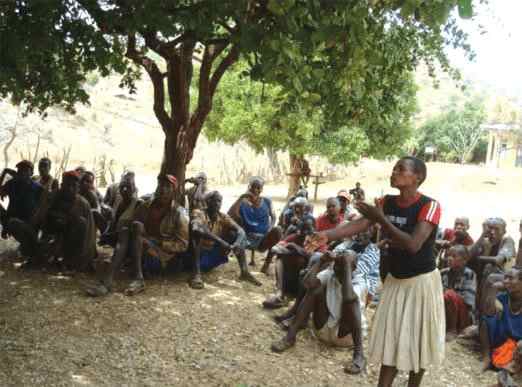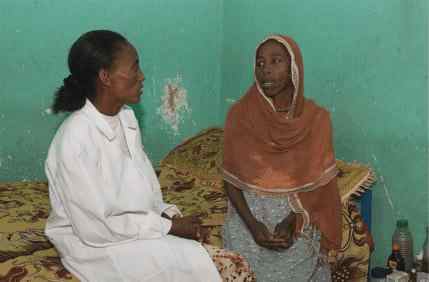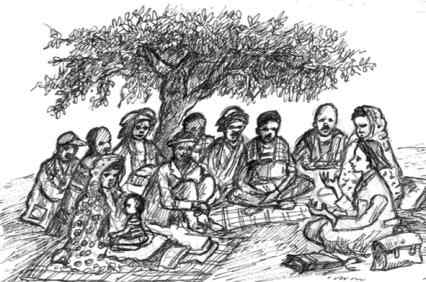
Maternal health care service utilisation is important for the improvement of both maternal and child health. In a study of six African countries, lower number of maternal and neonatal mortality and morbidity were shown when mothers give birth in a health facility with the help of skilled medical personnel. These study results show the importance of having an increased number of women to give birth in health institutions with the assistance of trained staff/skilled attendant so as to avoid the needless death of mother and child.
As you have seen in the above section, despite the fact that institutional delivery provides a much better and safer service than home delivery, all data indicate that a vast majority of women still not utilise the service.
Among most of the factors you studied in previous sections, a lower educational level of women is the one which could be easily addressed with a much lesser but very effective intervention called health promotion and communication. The fact that a huge number of women still think of institutional delivery as "unnecessary", clearly show you the prevailing high awareness gap among our community and women in particular. This also shows the need to have an immediate and large-scale interventions targeting on improving women's educational opportunities. This can be achieved as a long-term action but could also be achieved in the short term through effective health education programs by addressing more women with no education. DHS study of 2011 also clearly indicates the need to have effective health education and information campaign as an important intervention to dispel the knowledge gap and negative attitudes of women towards institutional delivery.
Hence, as a health extension worker you could play a major role in promoting institutional delivery by applying the principles of health education and communication you learn in Module 2.
As you may remember from Module 2, any community health problem that demands health education intervention is based on the assumption: "that beneficial health behaviour will result from a combination of planned, consistent, integrated learning opportunities and scientific evaluation of programs in different settings."
You will follow the following principles and approaches in the promotion of institutional delivery in your community:
By principle participation also helps people to identify their need for change and promotes the ability to choose for themselves methods and strategies that will enable them to take action.




What do you want to address?:
Observes rules and norms of culture as appropriate. You have to understand the culture of the community and introduce new ideas with a natural ease and caution. Learns about traditional practices of the locality and recognise the richness and spiritual significance of the community and culture that could contribute to better utilisation of health institutions. This means you should be aware of the traditional beliefs regarding pregnancy and childbirth and cooperates and liaises with traditional healthcare system when possible so that you could promote or build on positive traditional practices. For instance, you could start from some of the positive aspect of the traditional practices done in the community like that of the traditional birth attendants good practice of allowing the presence of relatives, encouraging walking around, allowing free position in delivery, placing the baby on the mother's breast even before umbilical cord is cut.
You should also identify cultural attitudes and practices that prevent the utilisation of health service. Instead, you need to offer sound alternatives in place of the harmful practices. You must avoid using dogmatic statements contrary to existing belief, culture and practices since such approach will result in rejection and hatred. Therefore, your health educations should start from where people are (their existing reality) and slowly build up the discussion to allow them to understand, appreciate and internalise fresh ideas.
N.B. When you provide health education, you must also apply the principle and features of communication that you learn in Module two.
The role, relationship and responsibilities of Traditional Birth Attendants (TBA's) as an advocate for women and families to support safer birthing
Traditional Birth Attendants' (TBAs) assist 60% -80% deliveries throughout the world and are called by different names. Therefore, considering a large number of the community they serve, the positive perception of the community towards them and their ability to identify some level of obstetric problems compared with other community members, the need to involve TBAs in the promotion of institutional delivery is unquestionable. TBAs could be an important and helpful agent in advising and referring mothers during pregnancy and delivery. However, it is also equally important for you to respect them and their effort, acknowledge their contribution and make them an active participant (even a lead person) in the 1-5 household networks and the health development army. It is only through these partnerships you could make them an ally/partner in improving the health outcome of mothers and children. Studies show that establishing a partnership with TBAs will increase a healthy collaboration with TBAs which consequently results in an improved maternal and neonatal health outcome. So, being an important partner, TBAs should be actively involved at each step of your health promotion and communication practice.
Involve families, relatives, friends and the community in the development of institutional delivery
The health extension program support start from single families' to the community, making sure that there is no one left behind. So you have an excellent opportunity to come in direct contact with the whole family members (the mother, husband, relatives, etc.neineighbours, community leaders, religious leaders and the community. Therefore, you should use these opportunities to promote the importance of institutional delivery.
The 1-5 network, the existing community development groups, development armies are also another opportunity though which you could teach the community about the benefits of having a delivery with the assistance of a skilled health professional.
You could also inform the community that the service provided in the healthcare facility is women friendly: which respect the belief, culture and religion of the mother and the community. You could also use these opportunities to explain any myth the community have towards institutional delivery.